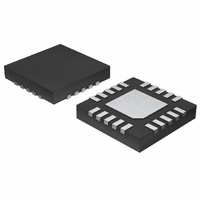MAX1844ETP+ Maxim Integrated Products, MAX1844ETP+ Datasheet - Page 12

MAX1844ETP+
Manufacturer Part Number
MAX1844ETP+
Description
IC CNTRLR STP DWN HS 20-TQFN
Manufacturer
Maxim Integrated Products
Type
Step-Down (Buck)r
Datasheet
1.MAX1844EEP.pdf
(24 pages)
Specifications of MAX1844ETP+
Internal Switch(s)
No
Synchronous Rectifier
No
Number Of Outputs
1
Voltage - Output
1.8V, 2.5V, Adj
Current - Output
4A
Frequency - Switching
200kHz, 300kHz, 450kHz, 600kHz
Voltage - Input
2 ~ 28 V
Operating Temperature
-40°C ~ 85°C
Mounting Type
Surface Mount
Package / Case
20-TQFN Exposed Pad
Power - Output
727mW
Output Voltage
1 V to 5.5 V, 1.8 V, 2.5 V
Output Current
4000 mA
Mounting Style
SMD/SMT
Switching Frequency
600 KHz
Maximum Operating Temperature
+ 85 C
Minimum Operating Temperature
- 40 C
Synchronous Pin
No
Topology
Buck
Lead Free Status / RoHS Status
Lead free / RoHS Compliant
Table 3. Operating Mode Truth Table
width is inversely proportional to input voltage and directly
proportional to output voltage. Another one-shot sets a
minimum off-time (400ns typ). The on-time one-shot is trig-
gered if the error comparator is low, the low-side switch
current is below the current-limit threshold, and the mini-
mum off-time one-shot has timed out.
The heart of the PWM core is the one-shot that sets the
high-side switch on-time. This fast, low-jitter, adjustable
one-shot includes circuitry that varies the on-time in
response to battery and output voltage. The high-side
switch on-time is inversely proportional to the battery
voltage as measured by the V+ input, and proportional
to the output voltage. This algorithm results in a nearly
constant switching frequency despite the lack of a fixed-
frequency clock generator. The benefits of a constant
switching frequency are twofold: first, the frequency can
be selected to avoid noise-sensitive regions such as the
455kHz IF band; second, the inductor ripple-current
operating point remains relatively constant, resulting in
High-Speed Step-Down Controller with
Accurate Current Limit for Notebook Computers
Table 4. Frequency Selection Guidelines
12
FREQUENCY
SHDN
TON = Float
TON = GND
TON = V
TON = REF
0
1
1
1
(kHz)
200
300
450
600
______________________________________________________________________________________
SKIP
GND
CC
V
X
CC
X
4-cell Li+ notebook
4-cell Li+ notebook
3-cell Li+ notebook
+5V input
Switching
Switching
APPLICATION
High or
High
Low
TYPICAL
DL
On-Time One-Shot (TON)
Run (PWM),
(PFM/PWM)
Low Noise
Shutdown
MODE
Fault
Run
Use for absolute best
efficiency.
Considered mainstream
by current standards.
Useful in 3-cell systems
for lighter loads than the
CPU core or where size is
key.
Good operating point for
compound buck designs
or desktop circuits.
COMMENTS
Low-power shutdown state. DL is forced to V
disabled. I
Low-noise operation with no automatic switchover. Fixed-frequency PWM action is
forced regardless of load. Inductor current reverses at light load levels. Low noise,
high I
Normal operation with automatic PWM/PFM switchover for pulse skipping at light loads.
Best light-load efficiency.
Fault latch has been set by overvoltage protection, output UVLO, or thermal shutdown.
Device will remain in FAULT mode until V
Q
.
CC
< 1µA typ.
easy design methodology and predictable output volt-
age ripple. The on-time is given by:
where K (switching period) is set by the TON pin-strap
connection (Table 4), and 0.075V is an approximation to
accommodate for the expected drop across the low-side
MOSFET switch. One-shot timing error increases for the
shorter on-time settings due to fixed propagation delays;
it is approximately ±12.5% at 600kHz and 450kHz, and
±10% at the two slower settings. This translates to
reduced switching-frequency accuracy at higher frequen-
cies (Table 5). Switching frequency increases as a func-
tion of load current due to the increasing drop across the
low-side MOSFET, which causes a faster inductor-current
discharge ramp. The on-times guaranteed in the
Electrical Characteristics are influenced by switching
delays in the external high-side power MOSFET.
Two external factors that influence switching-frequency
accuracy are resistive drops in the two conduction loops
(including inductor and PC board resistance) and the
dead-time effect. These effects are the largest contribu-
tors to the change of frequency with changing load cur-
rent. The dead-time effect increases the effective
on-time, reducing the switching frequency as one or
both dead times are added to the effective on-time. It
occurs only in PWM mode (SKIP = high) when the induc-
tor current reverses at light or negative load currents.
With reversed inductor current, the inductor’s EMF caus-
es LX to go high earlier than normal, extending the on-
time by a period equal to the low-to-high dead time.
For loads above the critical conduction point, the actual
switching frequency is:
f
On-Time = K (V
COMMENTS
=
CC
t
ON IN
V
power is cycled or SHDN is toggled.
DD
OUT
(V
if OVP is enabled and to GND if OVP is
+
+
V
V
DROP1
OUT
DROP2
+ 0.075V) / V
)
IN











